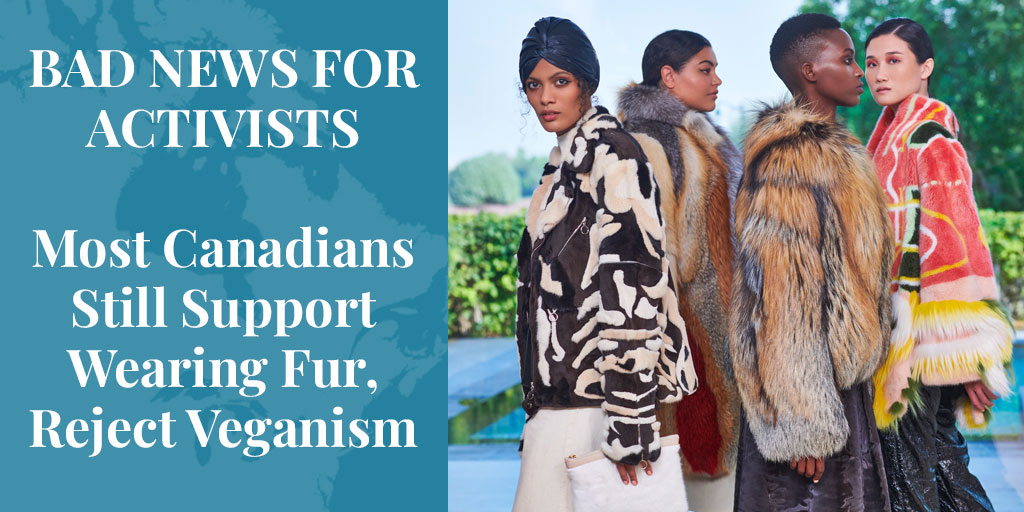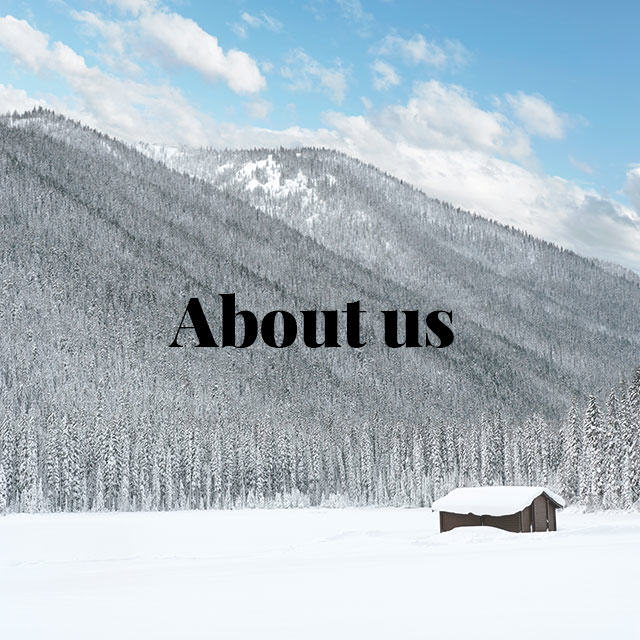
A major new public opinion poll shows that, despite decades of aggressive and misleading activist campaigning, most Canadians are still fine with wearing fur and other natural clothing materials — but are increasingly worried about the environmental costs of petroleum-based synthetics that activists love to promote as “vegan”.
The survey of 1,500 Canadians was commissioned by the Natural Fibers Alliance, and conducted in August 2022 by Abacus Data, a leading public affairs and market research consultancy.
SEE: Canadian Public Opinion on Mink Farming and Fur Use, and Public Opinion on Fur & Mink in Canada. By Abacus Data, August 2022.
The research completely contradicts animal activist claims that fur is no longer socially acceptable. In fact, two-thirds (65%) of Canadians believe that wearing fur is acceptable so long as the industry is well regulated and animals are treated humanely. Only one in five (21%) of Canadians do not agree – with just 10% saying they “strongly disagree”.
More than three-quarters (77%) of Canadians also believe that wearing fur is a matter of personal choice – putting the lie to activist claims that the public supports their call for fur bans. (Politicians take note!)
Seven in ten (71%) Canadians also agree that warm clothing is a necessity in many countries, and that natural fur is a sustainable warm clothing choice.
It is fascinating to see that, despite years of activist propaganda against mink farming, 35% of Canadians have a positive view of the sector while 25% are “neutral”, and only 21% have a negative view – of which only 10% are “very negative” – about mink farming. (18% feel they don’t know enough to form an opinion.)
Encouraging for Mink Farmers

Mink farmers will also be encouraged to learn that younger people tend to have a more positive view of their sector: 41% of 18-29-year-olds have a positive view of mink farming, compared with 35% of 30-60-year-olds, and 25% of those over 60. Again, these findings completely contradict activist claims that the future is theirs.
Strong pluralities of Canadians also believe that the mink farming sector supports rural communities (41%; versus 8% who disagree); that it is environmentally sustainable (38%; versus 12% who disagree); and that it takes care to maintain animal health and welfare (37%; versus 16% who disagree.) About one in five Canadians are “neutral” about these questions, while the balance don’t feel they know enough to state an opinion.
More broadly, this study completely debunks activist claims that the public is buying into their no-animal-use, vegan agenda. Despite all the hype we see these days about vegan products and vegan menu choices, 96% of Canadians are still open to eating animal products like eggs and dairy, while 90% think it’s OK to eat meat. So much for the vegan wave!
SEE ALSO: What Is “Vegan Fashion” and How True Is the Hype? Truth About Fur.
Consumers Worried by Synthetics
Three-quarters (74%) of Canadians also say they are comfortable with people wearing clothing or accessories made from leather, fur, wool, down, or other animal-derived natural fibres. (15% are “not too comfortable” with such choices, while only 7% of Canadians say they are “not at all comfortable” with animal-derived clothing materials.)
In fact, it is not fur or other animal-derived natural clothing materials that have consumers worried, but petroleum-based synthetics. 83% of Canadians are concerned that such synthetics – now in more than 60% of all our clothing – don’t biodegrade. 86% worry that synthetic fibres pollute our waterways and poison aquatic life. 83% are concerned about microplastics in our food and water.
SEE ALSO: The Great Fur Burial. Truth About Fur.
Because of such concerns, most Canadians (87%) now feel we should strive to use fewer synthetic fibres in our clothing (58%), or phase them out completely (29%).
Two-thirds of Canadians, in fact, now believe that “fast fashion” is contributing to an ecological crisis – and 60% of consumers feel that an environmental fee should be applied to all non-renewable clothing materials, because of their impact on the environment!
Again, completely contradicting activist claims, most consumers (77%) believe that natural fur is a more environmentally sustainable clothing choice than synthetics. Nearly two-thirds (64%) also believe that fur is a more socially responsible choice, while 59% consider fur to be a more ethical choice than synthetics.
SEE ALSO: Is It Ethical to Wear Fur? Truth About Fur.
Important Lessons
Bottom line, this new research provides some important lessons for the fur trade, the fashion industry, consumers, politicians, and the media:
1. The Fashion Industry: Designers, manufacturers, and retailers should listen to their consumers. Contrary to activist claims, most Canadian consumers do want to buy and wear fur, leather, wool, and other animal-derived products, so long as they are produced responsibly and sustainably. In fact, consumers today are more comfortable with responsibly produced animal-based clothing products than they are with petroleum-based synthetics.
2. Politicians: This research puts the lie to activist claims that Canadians want mink farming banned. In fact, more Canadians have a positive impression of mink farming than a negative impression, and more believe that the sector respects animal welfare and environmental sustainability. The research also completely debunks activist claims that the public want the sale of fur products banned. Quite the contrary, an absolute majority of Canadians believe that it is morally acceptable to use fur, and more than three-quarters believe that wearing fur should be a matter of personal choice. (The father of the current Canadian prime minister, Pierre Elliot Trudeau, once famously said that “the government has no place in the bedrooms of the nation”. It’s time to remind politicians that they shouldn’t be in our clothes closets either!)
3. Consumers: Those who appreciate its warmth, comfort, and beauty can wear fur with confidence, knowing that most Canadians agree that wearing fur is morally acceptable, environmentally sustainable, and a matter of personal choice.
4. Media: With this research at hand, journalists should stop giving a free ride to fraudulent activist claims that “consumers no longer accept that wearing fur is ethical”, or that “80% of Canadians want fur farming banned.” This research shows clearly that it is petroleum-based synthetics that have Canadians worried, and that most think that fur and other responsibly-produced animal-based clothing materials are a better environmental choice.
5. People of the Fur Trade: This research provides a powerful and timely response to anti-fur propaganda — but it is only useful if it is seen by others. It is up to people in every sector of the fur trade – trappers, farmers, designers, manufacturers, and retailers – to make sure this important information is widely circulated. Share this summary with your local and regional politicians. Use these statistics to respond whenever you see activist lies reported in the media — and to reassure customers, friends and neighbours.
Charles Dickens’ classic novel A Tale of Two Cities begins with the wonderful sentence: “It was the best of times, it was the worst of times.” This describes very well the situation of the fur trade today. Clearly the industry has been seriously damaged by decades of activist bullying and lies. At the same time, the growing public concern for protecting the environment provides a golden opportunity for the fur trade: when it comes to responsibly and sustainably produced clothing, fur checks all the boxes. We have long known this, and now we have the statistics to prove that many Canadians understand it too.
It’s now up to everyone in the trade to share and promote this important news!
SEE ALSO: A Behind-the-Scenes Look at the First Round of Negotiations for a Global Plastics Treaty. By Olivia Rosane for EcoWatch, Dec. 9, 2022.
***
To learn more about donating to Truth About Fur, click here.











I often go for a walk in the park wearing one of my full length fur coats… they are older coats which seem to be more accepted, but I have never really come across any negative comments.. no one really seems to care.. You do get the occasional sideways glare sometimes but you just learn to shrug it off… It was funny the other day I was wearing my full length raccoon and a woman asked is that real fur… she was rather the disappointed type… I politely said yes, and she kind of huffed… I then asked her if that was real coyote fur on Canada goose parka… the look on her face was priceless… so the funny thing is seems you can wear a fur hat, or fur mitts, or fur trim.. but the second its an actual fur coat its different? Makes no sense to me… Wear whatever you want, if you want to walk around in a T Shirt and shorts in the snow go for it.. Im more than happy in a fur coat.
Good point about trim being more “acceptable” than a full-length fur. It’s the same – or even more so – with fishing lures. No one bats an eyelid if your lure uses real caribou fur. Does anyone use fake fur for fishing???
So happy to read that the majority of Canadians prefer the sustainable side and qualification it as a personal choice. We Dutchies can learn from you guys!
I’m getting so tired of the aggressive methods by P. E.T.A. Imposing their hate and criminal activities on normal everyday people in public.. for that I started wearing real fur more often because I stand behind sustainability and I just love fur.
Wishing the Netherlands is following the progressive side asap in the way how open minded Canada is about wearing fur for men and woman.
Totally agree that petroleum based synthetics is ruining the world! At least the animals are treated well in mink/foxfarms, don’t let me start about all the waste of fast fashion industries what the ‘not wearing fur people’ wear all day- everyday… and microplastics ending op in the ocean and eventually ending up in our dishes causing diseases.
CANADA keep up the good work
Optimistic numbers for all fur fashion supporters! Hopefully the fur industry will survive, at least in Canada! It turns out that only a small but noisy minority speaks against the fur fashion. I hope the politicians will have the courage to oppose all those activists. I firmly believe that what we wear must be a matter of our personal choice. I wear real fur and leather with confidence. Thank you for your good work and keep on. I feel always grateful to all that trappers, fur farmers, furriers and other men, whose work I can wear.
“59% consider fur to be a more ethical choice than synthetics.” – what the f is wrong with these people? How killing millions of animals is more ethical?
Also, seems no one heard about the eco-friendly faux fur option.
In answer to your first question, we believe this page explains the ethical arguments in favour of fur: https://www.truthaboutfur.com/ethics-of-fur/
As for “eco-friendly faux fur”, it simply doesn’t exist yet, at least not commercially. The day will come when fake fur can be made in a sustainable manner from renewable, biodegradable, organic material, but that still seems to be years off. In the meantime, people are increasingly recognising that petrochemical-based synthetics – like those used in fake fur – are the antithesis of “eco-friendly”.
Thank you for the reply. There are commercially available eco-friendly fur garments. Not much, but a little bit more every year. Not only those who like animal fur recognise that petrochemical-based synthetics are not eco-friendly. A lot of people care about animal welfare AND sustainability at the same time. Seems like most people don’t know about toxic chemicals used in mass-production plants to process the animal pelts to prevent them from rotting. There is nothing sustainable in mass-production fur garments.
We already have too much clothes, why to throw them away and make new ones when whe can use/repurpose/recycle what we already have. I’ve seen people selling repurposed/resewn fur garments, there’s also plenty of pre-owned fur boutiques.
And there is nothing ethical about keeping animals in cages for the luxury goods, which are not necessary, and sometimes bought by those who already have wardrobes full of warm coats.
Natural material will always be much more eco-friendly than synthetics. You are completely wrong. Milions of animals are kept in cages and killed for meat and leather, too. Is it unethical? I do not think. Fur is the same. You cannot judge what is necessary or not. How many warm coats would you allow pro person? Just one? Zero? Or infinite number if they were all made of synthetics? I have more than one coats with natural fur, too, and can’t see anything bad about it. It is much better than synthetics, for me and even for our planet.
You would only see something wrong with it if you yourself were the victim. Also great excuse, the old “Well so and so people are committing mass theriocide, so I should too”. Or maybe both sides could just not hurt any at all.